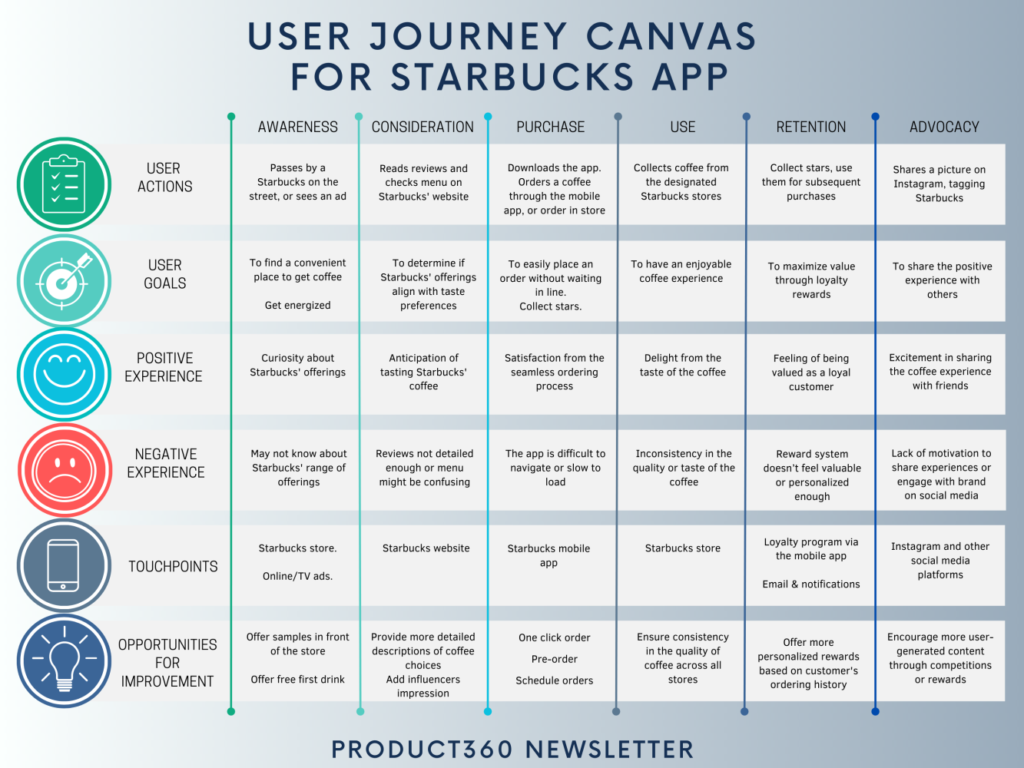Picture this: It’s a chilly winter evening and Sarah’s old heater just broke. With the prospect of a bone-chilling night ahead, she hops onto her smartphone, searches for a new heater and a home electronics website pops up. She clicks, scrolls through a few options, compares features, checks reviews, and eventually buys one. It arrives on her doorstep the next day, and she spends a cozy, warm night in her apartment.

In this narrative lies the complex web of User Journey Design. Simple, yet holds the feelings, actions, desires, and needs of our customers. User journeys instill empathy for our customers, allowing us to view situations from their standpoints. This empathy enables us to identify their pain points and craft the most effective solutions.

This guide will take you on a deep dive into this critical facet of product management and strategy. By understanding, testing, and optimizing the user journey, businesses can transform an ordinary user experience into an extraordinary one.
Understanding the User Journey
User Journey Design is a multifaceted discipline. It hinges on the comprehension of users’ motivations, behaviors, pain points, and goals, as they interact with a product or service across different stages. Think of it as the digital blueprint of your user’s experience, from the first trigger that gets them to use your product or service, to their eventual transformation into loyal customers.
User journey design encompasses the full spectrum of a user’s experience, from the emergence of a need, well before the product is engaged, through to their interaction long after the product has been used. Each action, every touchpoint, contributes to this narrative, creating a comprehensive roadmap that goes beyond the immediate product experience.
Integral to this journey are the micro-moments – small, often subtle interactions that shape a user’s decisions. Coupled with this, the emotional journey the user experiences at each stage is a pivotal aspect of the user journey. This emotional design approach ensures that the journey resonates with users on a deeper level, resulting in an engaging and memorable experience.
Omnichannel Consistency
Users have access to plenty of platforms – desktops, mobile devices, physical stores, and even smart TVs. Providing a seamless, consistent experience across these channels is vital. This approach, known as Omnichannel Consistency, ensures that whether Sarah is shopping on her smartphone or browsing in-store, her experience is fluid and coherent across all platforms.
73% of customers use multiple channels during their shopping journey (Harvard Business Review). With this in mind, a disjointed journey across different channels can often lead to frustrated users and, consequently, lost sales opportunities.
Take action: Evaluate your product’s omnichannel consistency. Are users transitioning smoothly between platforms and locations? Identify areas that could be refined to facilitate seamless transitions and maintain a steady, consistent user experience

Crafting the User Journey: Who, What, How
Designing the user journey involves a triage of understanding who your users are, what they want to achieve, and how they plan to achieve it.
Who: This is your user, and understanding them involves meticulous user research. Know their demographics, psychographics, behaviors, needs, and motivations.
What: These are the user’s goals. What does Sarah want to accomplish? In our opening story, her goal was to find a heater that would keep her warm throughout winter.
How: This involves charting out the user’s path to goal completion – the stages they go through, the decisions they make, and the emotions they experience at each step.
This trifecta forms the basis for creating the User Journey Map – a visual representation of the user’s interaction with the product/service.
The User Journey Map Is A Blueprint to Success
A User Journey Map is a strategic tool for empathy, a window into your user’s mind. It details the steps, decisions, and emotions of a user during their interaction with your service or product. A typical User Journey Map includes:

- User Persona: This is a detailed profile of your user based on your user research, many products require a user journey map for each persona.
- Stages: These are the phases that a user goes through in their interaction. They could include awareness, consideration, purchase, use, retention, and advocacy.
- Actions, Mindsets, and Emotions: What is the user doing, thinking, and feeling at each stage?
- Opportunities and Pain Points: Identify the areas where users struggle and where there are opportunities for improvement or innovation.
Tip: Consider including multiple scenarios in your User Journey Map. For instance, one could illustrate the path of a returning customer, while another might represent a user encountering your service for the first time.
Secret Shopper: The Unseen Observer

You have a running business and a team that’s operating and interacting with customers on a daily basis, there are two questions you need to ask:
- Can you be certain your team is providing the best service at all times?
- What can be improved so that your customers would love to return and interact with your product, service, or team again?
This is the moment when a secret shopper can truly make a difference.
The Secret Shopper methodology involves immersing yourself in the user’s shoes to gain first-hand experience of the journey. By personally undergoing the user’s journey, you’re able to uncover obstacles, inefficiencies, or even opportunities that data alone may not reveal.
Hiring a secret shopper to conduct undercover research of your business can be tricky and it requires careful planning and detailed analysis efforts to collect the right data and generate actionable insights. Contact us at goproduct360.com or send to me directly if you’re interested in applying the secret shopper experience at your business and generating valuable insights that won’t be available otherwise.
The secret shopper can identify points where the user might feel overwhelmed, lost, or even delighted – invaluable insights that can significantly improve your user journey design.
What’s next?
Once the User Journey Map is in place, it’s time to bring it to life and see it in action. Testing is crucial, allowing for validation and refinement.
Use A/B testing to understand which design or feature users prefer. Conduct usability testing to gauge the ease and convenience of the user journey. Utilize analytics to assess user behavior and the overall effectiveness of your user journey design.
Integrating your findings into the design process is the next step. The insights from your tests will lead to optimization – enhancing the user journey for better user satisfaction and engagement.
Remember, User Journey Design is iterative. As you gather more insights and your product evolves, your user journey must adapt accordingly.
User Journey and Product Management
The User Journey is not just a design tool; it plays a pivotal role in overall product strategy and management.
An optimized user journey will enhance user satisfaction, increase user engagement, and drive conversions – all key performance indicators in product management.
It also provides invaluable insights for product development. Knowing when, where, and why users struggle allows for targeted product improvement. Conversely, understanding what users love can lead to the development of features that capitalize on these positive moments.
A Never-Ending Journey
The design of the user journey is a never-ending process. As the market evolves, so will your users and their needs. By continually optimizing the user journey, you ensure that your product remains relevant, engaging, and successful.
Remember our friend Sarah? Her journey started with a broken heater and a quick online search. But with a well-designed user journey, you have the power to turn that casual search into a story of brand loyalty and user satisfaction.
As you embark on the exciting journey of User Journey Design, remember the guiding principle: It’s not just about getting users to your product; it’s about creating an experience they love, one micro-moment at a time.
Embrace the fluidity, the nuances, and the potential of the user journey. After all, it’s these unique journeys that turn users into loyal customers, and businesses into success stories.
Now, take this blueprint and get started on designing a user journey that’s not just efficient and effective, but also emotional and engaging. You have the tools, the knowledge, and the power to make a difference – one user journey at a time.
Introducing User Journey Canvas
The User Journey Canvas is a powerful tool that helps bring the user journey to life. With it, you can dissect, analyze, and reimagine your user journey, making sure every touchpoint is engaging, and smooth, and leaves your user wanting more.
As an example, let’s consider how you might use the User Journey Canvas to examine the Starbucks mobile app’s user journey:

Would you like to use our User Journey Canvas template? Leave a comment below, and we’ll share the link with you. Start crafting a journey your users will love!
>> Subscribe to our newsletter to get more insights on product management, including tips on setting effective success metrics for your products. Don’t miss out on the latest trends, frameworks, and best practices in the industry. Join the PRODUCT360 community today!


